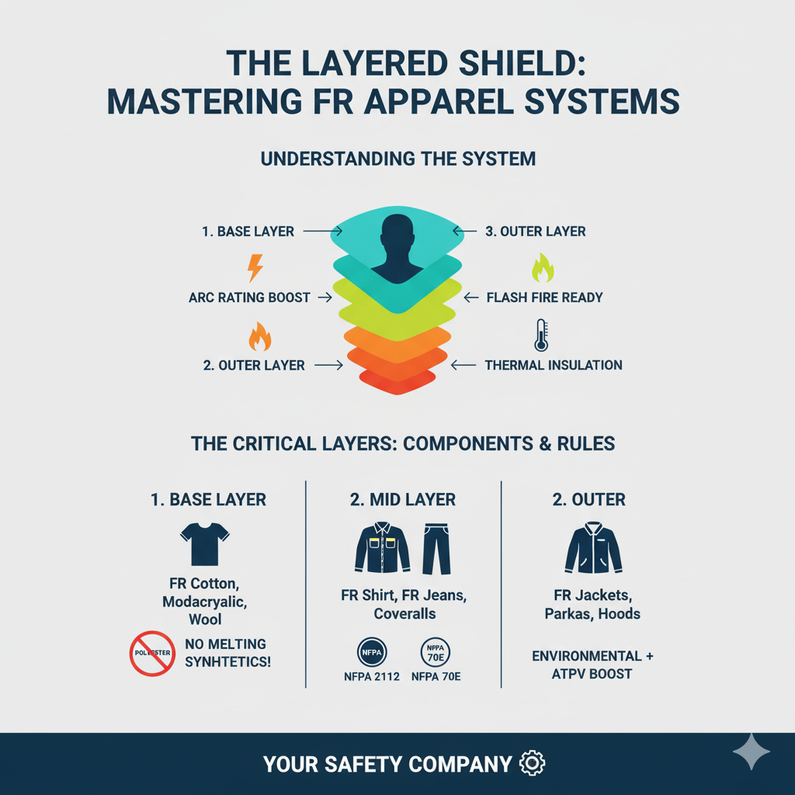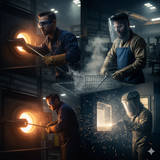The Layered Shield: Mastering FR Apparel Systems for Maximum Safety and Comfort
In extreme thermal hazard environments, such as those found in utility maintenance, electrical repair, and oil and gas operations, one garment is rarely enough. True protection against arc flash and flash fire is achieved through a deliberate layering system of Flame-Resistant (FR) apparel.
Layering is a powerful concept: multiple thin layers of FR clothing provide superior protection compared to a single, thick, bulky garment. It not only boosts the overall Arc Thermal Performance Value (ATPV) but also dramatically improves comfort and adaptability for the wearer.
However, layering FR clothing is governed by strict, life-saving rules. A single non-FR item, particularly one made of synthetic material, can melt onto the skin during an incident, instantly negating the protection of the entire system.
At Your Safety Company, we advocate for intelligent safety. Here is your essential guide to building a compliant and comfortable FR layering system.
The Power of the FR Layering Principle
Layering provides two distinct advantages in thermal hazard environments:
-
Boosting ATPV (Calorie Rating): The calorie ratings of multiple FR garments are additive. For example, wearing a 4 cal/cm² FR base layer shirt under an 8 cal/cm² FR outer shirt results in a much higher total system ATPV (often around 12 cal/cm²), placing the worker in a higher safety category (CAT 3 or CAT 4) without requiring a single, heavy garment.
-
Air Gap Insulation: Trapped air between layers acts as an additional thermal barrier. In a flash fire or arc flash, this air gap helps block heat transfer to the skin, drastically reducing the potential for severe burns.
The Three Critical Layers
A proper FR layering system consists of three parts, all of which must be non-melting materials:
1. The Base Layer (Against the Skin)
-
Function: Manages moisture and contributes directly to the system's total thermal protection.
-
Acceptable Materials: FR-rated cotton, inherently FR synthetics (like Nomex or specialty FR blends), wool, or 100% heavy cotton (though FR-rated is always preferred).
-
THE GOLDEN RULE: NEVER wear athletic wear, polyester, rayon, nylon, or spandex base layers. These materials will melt onto the skin in an arc flash, causing severe burns.
2. The Mid Layer (Shirts, Pants, Coveralls)
-
Function: Provides the core thermal protection, meeting the minimum required ATPV for the worker's category.
-
Acceptable Materials: FR-treated cotton, FR denim, or specialized inherent FR fabrics.
-
The Go-To: This layer is typically the daily uniform—your FR shirt and FR jeans—certified to standards like NFPA 2112 (flash fire) and NFPA 70E (arc flash).
3. The Outer Layer (Jackets, Vests, Parkas)
-
Function: Provides environmental protection (cold, rain, wind) while adding a significant boost to the overall ATPV rating.
-
Acceptable Materials: FR-rated outerwear, often with features like water resistance or high-visibility colors.
-
Integration: Ensure any outer layer integrates smoothly with the rest of the PPE, such as being compatible with hard hats and fitting well over the mid-layer without compressing it too tightly (which would eliminate the protective air gap).
The Essential FR Compliance Checklist
Before sending your team out in layered FR, verify these compliance points:
-
All Layers Must Be FR/Non-Melting: This cannot be overstated. From socks and underwear to the outermost jacket, every piece of fabric must be verified.
-
ATPV Calculation: Use the certified ATPV ratings from your specific garments to calculate the total system rating. Do not rely on estimates.
-
Proper Fit: Garments must fit loosely enough to allow air flow and preserve the protective air gap, but snugly enough to prevent snag hazards.
-
Care and Maintenance: The integrity of the layering system relies on each garment's inherent protection. Always follow the manufacturer's care instructions to ensure the FR properties are not compromised by bleach or fabric softeners.
Your Safety Company: Equipping Your Integrated System
Mastering the layered shield is essential for maximizing protection and maintaining comfort in high-hazard roles. By understanding how layers interact and adhering strictly to the non-melting rule, you ensure your team is prepared for the worst while working efficiently every day.
At Your Safety Company, we offer a complete, certified FR apparel system—from base layers and shirts to specialized outerwear—designed to work together seamlessly to meet your specific NFPA 70E and NFPA 2112 requirements.
Don't let a simple clothing mistake compromise your entire safety program. Visit yoursafetycompany.com today to explore our comprehensive FR layering solutions.
Recent Posts
-
More Than Goggles: The Specialized Eye Protection Needed for High-Heat Industrial Environments
In facilities that process metal at extreme temperatures, eye safety is a complex, multi-layered cha …12th Nov 2025 -
Double Defense: Why Cut and Impact Protection is Critical for Material Handling
In facilities that deal with heavy metal parts, sharp edges, and complex machining, a standard work …11th Nov 2025 -
Beyond the Flame: Why NFPA 2112 FR Apparel is Non-Negotiable
In high-risk industrial settings—from petrochemical plants and utilities to metal processing and hea …7th Nov 2025



